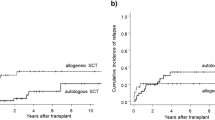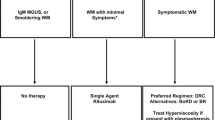Abstract
Waldenstrom’s disease is a lymphoproliferative disorder that is typically treated with plasmapheresis and/or alkylating agents. In young patients, other lymphoproliferative disorders have been treated with allogeneic transplantation. Two patients with aggressive Waldenstrom’s disease, who progressed in spite of multi-agent chemotherapy and autologous stem cell transplantation, in one case, underwent allogeneic transplantation from their HLA-identical donors. Both remain alive with event-free survivals of more than 3, and more than 9 years, respectively. Allogeneic transplantation should be considered for young patients with Waldenstrom’s disease.
Similar content being viewed by others
Author information
Authors and Affiliations
Rights and permissions
About this article
Cite this article
Martino, R., Shah, A., Romero, P. et al. Allogeneic bone marrow transplantation for advanced Waldenstrom’s macroglobulinemia. Bone Marrow Transplant 23, 747–749 (1999). https://doi.org/10.1038/sj.bmt.1701633
Received:
Accepted:
Published:
Issue Date:
DOI: https://doi.org/10.1038/sj.bmt.1701633
- Springer Nature Limited
Keywords
This article is cited by
-
Stem cell transplant for Waldenström macroglobulinemia: an underutilized technique
Bone Marrow Transplantation (2012)
-
Long-term graft-versus-Waldenström macroglobulinemia effect following reduced intensity conditioning allogeneic stem cell transplantation
Bone Marrow Transplantation (2007)
-
Evidence of graft-versus-Waldenstrom's macroglobulinaemia effect after allogeneic stem cell transplantation: a single centre experience
Bone Marrow Transplantation (2007)
-
Stem cell transplantation (SCT) for Waldenstrom's macroglobulinemia (WM)
Bone Marrow Transplantation (2002)
-
High-dose chemotherapy followed by stem cell transplantation in patients with resistant Waldenstrom's macroglobulinemia
Bone Marrow Transplantation (2001)




